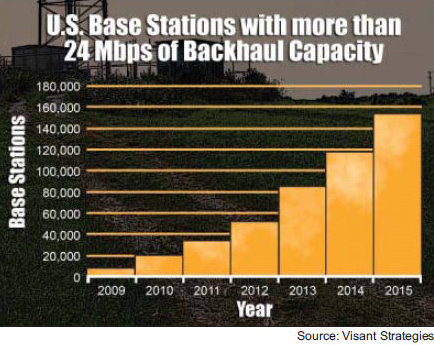This summarizes a selection of applications for the Experimental Radio Service received by the FCC during September-December 2012. These are related to LF and HF propagation, cognitive radio, satellite telemetry, ultra-wideband (UWB), ground-penetrating and synthetic-aperture radar, mobile broadband, aerial communications (balloons), LTE, managed access, military communications, Wi-Fi, GPS, sensor networks, and MVDDS. The descriptions are sorted by the lowest frequency in the application.
Archive for the ‘Backhaul’ Category
Qualcomm outlines vision of 1000x mobile capacity increases
Wednesday, August 29th, 2012In the first of a series of webinars, Qualcomm today began reporting on the results of its “1000x Data Challenge,” an initiative to meet what it sees as the need, someday, to increase mobile capacity 1000-times. The webinar, conducted by Rasmus Hellberg, Qualcomm’s Senior Director of Technical Marketing, was an overview. He discussed spectrum, small cells, and other techniques to increase capacity. More-detailed webinars on each of these are forthcoming: spectrum initiatives on September 18, small cells and heterogeneous networks on October 18, and more efficient networks, applications, and devices on November 14. Today’s webinar should be posted tomorrow, and a white paper should appear in about a week.
Experimental Radio Applications at the FCC
Sunday, February 5th, 2012This summarizes a selection from 215 applications for the Experimental Radio Service received by the FCC during October, November, and December 2011. These are related to AM broadcasting, FM broadcasting, spread spectrum on HF and VHF, unmanned aerial vehicle control, electronic warfare support, small satellites, white space technology, video production, managed access, TV interference, RFID, and radar. The descriptions are listed in order of the lowest frequency found in the application.
Experimental Radio Applications at the FCC
Monday, June 13th, 2011This summarizes a selection of applications for the Experimental Radio Service received by the FCC during April and May 2011. These are related to TV white space, electromagnetic compatibility testing, train control, point-to-multipoint communications, satellite communications, radar, unmanned aerial vehicles, GPS, ultra-wideband, mobile satellite service, UMTS, mobile broadband picocells, wireless backhaul, and IEEE 802.11p. The descriptions are sorted by frequency.
Reports from NAB and CTIA Address Efficient Use of Spectrum
Saturday, May 14th, 2011AT&T and T-Mobile – Interpreting the Spin
Friday, March 25th, 2011Backhaul trends: higher rates, more wireless
Wednesday, February 17th, 2010A 4G base station can’t be any faster than its backhaul. An article in the February 2010 issue of AGL magazine, written by analysts at Visant Strategies, looks at how backhauls improving in speed to match new air interfaces. Over the next five years, they see the number of base stations having more than 24 Mbps of backhaul capacity increasing more than 20-times.
Today most backhaul links are wireline; through 2015, the percentage of wireless versus wireline backhaul links is predicted to increase, with percentages about even by 2016. The number of backhaul links in wireless networks is predicted to increase from 300,000 in 2008 to 500,000 in 2015.
